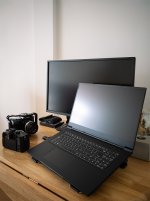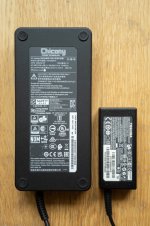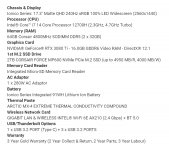Hey everybody,
Here's my first impression of the 2022 PCS 17" Ionico.
The same TongFang barebones is used by a handful of other brands and there's a very good, in-depth test on this laptop on Notebookcheck already. I found that after purchasing my machine from PCS actually. Their analysis is really detailed, I am not going to waste space repeating any of their findings.
My review is from a filmmaker / video editor perspective.
I hit the character limit so the key specs of my build are in the attachment.
Background:
I wanted a (fairly) mobile workstation to view and edit any demanding video format on the planet.
I am mainly using Premiere Pro and for that the RTX 3070 or even a 3060 could have been sufficient. Planning to learn Resolve however and apparently the 16 gig VRAM on the 3080 can make a difference.
Let’s start with the cons:
Mild bleeding on my sample. I could do without the hot-spot in the lower left corner, but I have seen much worse. I sent back a 15” Ionico two years ago with clouding that I couldn’t tolerate.
When you are watching anamorphic content, having even black bars is desirable. Do anything else that fills the whole screen and the bottom bleed is not noticeable.
Now on to the pros:
The laptop was in Turbo Mode, plugged into the wall.
INT - internal drive / EXT - external drive
(O) - Orico USB-C 3.1 external enclosure
https://www.amazon.co.uk/gp/product/B07NCDSPWL
(A) - Atomos USB-C 3.1 docking station
https://www.amazon.co.uk/Atomos-Docking-Station-USB-C-3-1-Black/dp/B07J34K4G6
External drive: OWC 500GB SSD OWCS3D7E6G500
https://www.amazon.co.uk/OWC-Mercury-Electra-Serial-OWCS3D7E3G500/dp/B074ZNZCP
Scores:
1) Read from INT, Render on INT, No GPU boost, Fan default - Extended: 931, Standard: 1079
https://www.pugetsystems.com/benchmarks/view.php?id=91613
2) Read from INT, Render on INT, 25w GPU boost, Fan default - Extended: 811, Standard: 864
https://www.pugetsystems.com/benchmarks/view.php?id=91612
3) Read from INT, Render on INT, No GPU boost, Fan boost ON - Extended: 1016, Standard: 1151
https://www.pugetsystems.com/benchmarks/view.php?id=91625
4) Read from INT, Render on EXT (O), No GPU boost, Fan boost ON - Extended: 691, Standard: 774
https://www.pugetsystems.com/benchmarks/view.php?id=91622
5) Read from INT, Render on INT, 13w GPU boost, Fan boost ON - Extended: 846, Standard: 880
https://www.pugetsystems.com/benchmarks/view.php?id=91631
6) Read from EXT (O), Render on INT, No GPU boost, Fan boost ON - Extended: 850, Standard: 1036
https://www.pugetsystems.com/benchmarks/view.php?id=91636
7) Read from EXT (A), Render on INT, No GPU boost, Fan boost ON (Boost turned itself off halftime) - Extended: 1057, Standard: 1188
https://www.pugetsystems.com/benchmarks/view.php?id=91649
8) Read from EXT (A), Render on INT, No GPU boost, Fan boost ON, Cooling pad - Extended: 1069, Standard: 1187
https://www.pugetsystems.com/benchmarks/view.php?id=91844
9) Read from EXT (A), Render on INT, No GPU boost, Fan default, Cooling pad - Extended: 896, Standard: 935
https://www.pugetsystems.com/benchmarks/view.php?id=91841
10) Read from EXT (A), Render on INT, No GPU boost, Fan curve adjusted, Cooling pad - Extended: 1030, Standard: 1149
https://www.pugetsystems.com/benchmarks/view.php?id=91848
Before any sort of a deep dive, let's just say quickly that any system scoring near 1K in this benchmark should handle anything you throw at it. These are very good results for a laptop. The editing experience should be really smooth, hopefully for a long time to come.
At the moment I feel this laptop is a very good value for the money. Sure, you can get the same editing performance from a desktop rig for much less, but that’s not a fair comparison. This is a portable workhorse and at the moment Apple offers its rough equivalent for at least a grand more. Yes, that’s not necessarily a fair comparison either, I am sure the new M1 Macs are sexy, silent and.. Apple.
There is a long list of competing Intel laptops, however it's near impossible to find 64 gigs of DDR5 anywhere else. Most “creator” laptops top out at 32 and memory upgrades are not cheap. Do you always need 64, maybe not, but I feel better knowing choppy previews are twice less likely to happen in Premiere.
I hope you guys liked this write-up and I will probably update this topic with NeatBench results soon and long-term observations later.
Here's my first impression of the 2022 PCS 17" Ionico.
The same TongFang barebones is used by a handful of other brands and there's a very good, in-depth test on this laptop on Notebookcheck already. I found that after purchasing my machine from PCS actually. Their analysis is really detailed, I am not going to waste space repeating any of their findings.
My review is from a filmmaker / video editor perspective.
I hit the character limit so the key specs of my build are in the attachment.
Background:
I wanted a (fairly) mobile workstation to view and edit any demanding video format on the planet.
I am mainly using Premiere Pro and for that the RTX 3070 or even a 3060 could have been sufficient. Planning to learn Resolve however and apparently the 16 gig VRAM on the 3080 can make a difference.
Let’s start with the cons:
- I’ve been waiting for PCS to release a 12th gen laptop with Thunderbolt. I need TB for legacy hardware. Unfortunately, the 4th TB version on this build is not compatible with the Apple TB3 to TB2 and TB2 to FireWire converters. These accessories work on most TB3 Windows computers.
Once all the drivers are installed, there’s a Thunderbolt Control Center app, which is basically a connection gatekeeper. It monitors what you are attaching to the TB port. Sadly the converters don’t show. StarTech also makes a (pricey) TB3 to TB2 box, but at least they clearly state the device is not compatible with TB4.
This is a big bummer, I was really looking forward to selling my aging 4770K based PCI FireWire desktop PC. It seems I have to hold onto it.
- Listening to music via Bluetooth is glitchy. This can be one of those Windows gremlins that will disappear (or reappear) with an update, but at the moment hook-up to my speakers is unreliable.
Minor trouble, my office subnotebook takes care of this.
- No CPU undervolting.
The laptop heats up to 90 degrees really fast under load, hitting 100 celsius on occasion, even on a cooling pad.
Intel removed undervolting from all but one of their new CPUs, the top tier 12900HK.
The option is still present in the Control Center app, but the slider has no effect.
Heat can be reduced a bit by tweaking the PL settings, naturally some performance is lost. Adjusting the default fan curve is strongly recommended. More on that later.
- The charger is big. Easily the biggest laptop brick I have seen since 1997. Comparison included with the already mentioned subnote’s adapter. Charging time is reasonable, there is no USB power delivery unfortunately.
- The card reader. It’s microSD. I leave it at that.
Mild bleeding on my sample. I could do without the hot-spot in the lower left corner, but I have seen much worse. I sent back a 15” Ionico two years ago with clouding that I couldn’t tolerate.
When you are watching anamorphic content, having even black bars is desirable. Do anything else that fills the whole screen and the bottom bleed is not noticeable.
Now on to the pros:
- This laptop is easy on the eyes. No dragons, no flames, no samurai swords.
No branding either (apart from the splash screen at boot) and PCS left the lid plain.
It’s pleasing to touch the matt black magnesium.
- Perhaps gimmicky and they just eat the battery, but the RGB features are nice.
- Office mode. Battery life is very good here, the fans barely come on, temps are reasonable. Premiere Pro can be still used for basic edits in this profile, without plugged in the mains, even with a LUT and a few light color tweaks applied in Lumetri. You don’t want to render like this though.
- The powah. Yes, there is plenty of power under the hood. Let’s see some tests:
The laptop was in Turbo Mode, plugged into the wall.
INT - internal drive / EXT - external drive
(O) - Orico USB-C 3.1 external enclosure
https://www.amazon.co.uk/gp/product/B07NCDSPWL
(A) - Atomos USB-C 3.1 docking station
https://www.amazon.co.uk/Atomos-Docking-Station-USB-C-3-1-Black/dp/B07J34K4G6
External drive: OWC 500GB SSD OWCS3D7E6G500
https://www.amazon.co.uk/OWC-Mercury-Electra-Serial-OWCS3D7E3G500/dp/B074ZNZCP
Scores:
1) Read from INT, Render on INT, No GPU boost, Fan default - Extended: 931, Standard: 1079
https://www.pugetsystems.com/benchmarks/view.php?id=91613
2) Read from INT, Render on INT, 25w GPU boost, Fan default - Extended: 811, Standard: 864
https://www.pugetsystems.com/benchmarks/view.php?id=91612
3) Read from INT, Render on INT, No GPU boost, Fan boost ON - Extended: 1016, Standard: 1151
https://www.pugetsystems.com/benchmarks/view.php?id=91625
4) Read from INT, Render on EXT (O), No GPU boost, Fan boost ON - Extended: 691, Standard: 774
https://www.pugetsystems.com/benchmarks/view.php?id=91622
5) Read from INT, Render on INT, 13w GPU boost, Fan boost ON - Extended: 846, Standard: 880
https://www.pugetsystems.com/benchmarks/view.php?id=91631
6) Read from EXT (O), Render on INT, No GPU boost, Fan boost ON - Extended: 850, Standard: 1036
https://www.pugetsystems.com/benchmarks/view.php?id=91636
7) Read from EXT (A), Render on INT, No GPU boost, Fan boost ON (Boost turned itself off halftime) - Extended: 1057, Standard: 1188
https://www.pugetsystems.com/benchmarks/view.php?id=91649
8) Read from EXT (A), Render on INT, No GPU boost, Fan boost ON, Cooling pad - Extended: 1069, Standard: 1187
https://www.pugetsystems.com/benchmarks/view.php?id=91844
9) Read from EXT (A), Render on INT, No GPU boost, Fan default, Cooling pad - Extended: 896, Standard: 935
https://www.pugetsystems.com/benchmarks/view.php?id=91841
10) Read from EXT (A), Render on INT, No GPU boost, Fan curve adjusted, Cooling pad - Extended: 1030, Standard: 1149
https://www.pugetsystems.com/benchmarks/view.php?id=91848
Before any sort of a deep dive, let's just say quickly that any system scoring near 1K in this benchmark should handle anything you throw at it. These are very good results for a laptop. The editing experience should be really smooth, hopefully for a long time to come.
- The first thing that's really visible: GPU boost should be avoided. It’s probably generating too much heat, causing heavy throttling. I didn’t experiment with anything below 13w and just kept it totally off for any later testing. Keep in mind, this is a very Premiere Pro specific conclusion, if you are a gamer, it might not apply to you.
- Storage configuration matters. This should have been fairly obvious to me, it applies to every editing rig since the beginning of time, but I didn’t expect to see such poor results on external render. I thought some other part in the encoding would be the bottleneck, I was wrong.
- Reading, rendering and caching on the internal drive at the same time gave perfectly fine results. The PCIe storage did well here. This is not an ideal scenario of course, having a separate, internal cache or read drive would be still wise and probably improve scores further. An external read drive of course is a much more likely scenario, 4-8TB PCIe prices are high.
- Editing (reading) off an external, regular SSD seems to be totally fine. I am sure this is only news for me, but I was relieved. However it does matter what sort of a dock you are using. With the same drive, the Atomos clearly outperformed the Orico enclosure. In its defense, the latter costs about 3 times less.
Needs to be noted, I couldn’t find the right cable, so the Orico was plugged into a USB-A 3.2 Gen1 port and the Atomos dock was using the USB-C (TB) 3.2 Gen2 on the back.
Both should be fine for this old SSD but who knows, the Orico might have performed better via USB-C.
- The default fan profile in Turbo Mode is too “conservative”. The brute force, no compromise boost mode kept the fans on a hundred percent and the scores noticeably improved. Test 1 doesn’t look too bad, but keep in mind the hardware got a cool start. Test 9 is essentially the same scenario, I am just reading from an external drive. Even with the cooling pad (two extra fans) I am getting worse results. Probably because the hardware is already warm. Test 10, updated fan curve, I am above 1K again.
- The curve should let the fans go above 80%. I adjusted my profile to allow 100% from 50-60 celsius or so on the CPU and GPU as well. Unlike fan boost, this allowed (fairly) quiet times between sub-tests.
I don’t mind flexing the fans. I would rather get dying fans than a dying mainboard.
At the moment I feel this laptop is a very good value for the money. Sure, you can get the same editing performance from a desktop rig for much less, but that’s not a fair comparison. This is a portable workhorse and at the moment Apple offers its rough equivalent for at least a grand more. Yes, that’s not necessarily a fair comparison either, I am sure the new M1 Macs are sexy, silent and.. Apple.
There is a long list of competing Intel laptops, however it's near impossible to find 64 gigs of DDR5 anywhere else. Most “creator” laptops top out at 32 and memory upgrades are not cheap. Do you always need 64, maybe not, but I feel better knowing choppy previews are twice less likely to happen in Premiere.
I hope you guys liked this write-up and I will probably update this topic with NeatBench results soon and long-term observations later.
Attachments
Last edited:




